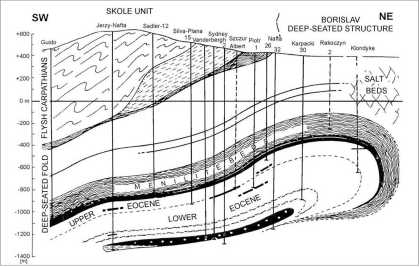869568704
Przegląd Geologiczny, vol. 55, nr 12/1, 2007

Fig. S. Cross-section of the Borislav oil field (by Tołwiński, 1937, modified)
Potoku” in Borislav and in 1896 it reached a petroliferous sandstone. From the depth of 900 m it obtained 401 of oil per day. Oil and gas occurrences in the eastern part of the Carpathians were stated already in 1853 but practically they initiated the exploitation of the oil field with deep dril-lingonlyin 1896.
Discovering of the “Borislav” oil field in 1896 activa-ted drillings and hydrocarbons exploitation mainly in the Eastern Carpathians. New oil-bearing layers were discove-red in so-called Borislav Sandstone (Oligocene in age) and Jamno Sandstone (of Paleocene age) from which were obtained 40-25001 of oil per day. From 1900 till 1909 the production of oil increased 6.5 times.
The Schodnica oil field played the important role, being at the end of XIX century the first in oil production in the Carpathians region. In 1892 it exploited 38001 of oil. In 1895, during one year, 17,000 t of oil were obtained from the “Jakub” borehole located in the same oil field (the Jamno sandstone was exploited at depth of303 m). In 1897 S. Szczepanowski founded his own oil minę in Słoboda Rungurska from which at first only 161 of oil per day were obtained. From financial-economical reasons it caused a minę failure.
Oil production in 1905 increased to 802,000 t and in 1907 — it reached 1.176 x 1061. Maximum production was in 1909 when it achieved 2.076 x 1061 of oil. To the most efficient boreholes belonged Wilno-2, Nafta-2 and 3, Litwa ones with a daily production of 800 t and the famous “Oil City” —2500 t/d.
The depth of oil-bearing horizons in the “Borislav” oil field was roughly 800-1400 m, but a lot of petroliferous sand-stones appeared at shallower depths (Fig. 5). Some boreholes in the Borislav region achieved the highest total production of250,0001. From the “Borislav” oil field ca 20 x 1061 were derived till 1938. After 1939 the Ukrainian geologists still discovered 2 deeper folds rich in oil. Resources of this oil field are estimated at 30 x 1061.
Exploitation in this region of the Carpathians in 1909 was 2 x 1061, i.e. 5.2% of world oil production and Galicia took the third place in the world.
Crucial meaning in the history of the oil industry had the “Oil City” borehole in Tustanowice in the vicinity of Borislav. Thirteenth June 1908 at the depth of 1016 m took place the unexpected eruption of oil and gas. During twenty four hours 140 carriages of oil were filled (it is ca 1400 t). The production of oil grew and the peak was achieved 3000 t/d. After the fire which happened 4 July and for extinguishing it after 30 days, the oil leakage was estimated at ca 2000 t/d. This oil and gas explosion caused a great ecological catastrophe. Oil was not collected into conta-iners and it flooded fields as well as it penetrated into the river Tyśmienica, a tributary of Dniestr River. The “Oil City” borehole appeared crucial for hitherto existing re-searches and sińce then new crews for further drillings were organized from the all Carpathians area.
During and just after the First World War, between Jasło and Krosno (Carpathians — Roztoki-Sądkowa in the Eocene flysch) as well as in the Carpathian Foredeep (the Daszawa and Opary gas fields in the Miocene deposits) considerable gas fields were discovered. These discoveries initiated construction of long gas pipelines. Especially the Daszawa gas field was important: borehole Daszawa-1 was begun in 4 October 1920, in 1921 from depth of 394 m the first gas was obtained in amount of 10 m3/min. Just after that the Daszawa-2 borehole was drilled and in 1923 the “Piłsudczyk” one where at depth of 753 m a huge gas inflow was documented.
The large contribution into the practical applying the results of geologie researches in the petroleum industry was activity of the Geologie Station in Borislav, renamed in 1932 to the Carpathian Geologic-Petroleum Institute, directed by Konstanty Tołwiński (1934-1937) (Fig. 6). In this Institute a few professional joumals were edited: “Nafta”, “Petroleum Statistics” and “ Oil Mining in Poland”.
1051
Wyszukiwarka
Podobne podstrony:
Przegląd Geologiczny, vol. 55, nr 12/1, 2007 Fig. 17. “Bamówko-Mostno-Buszewo” (BMB) oil-gas field i
Przegląd Geologiczny, vol. 55, nr 12/1, 2007 Fig. 12. Photo of Polish geologists team during the
Przegląd Geologiczny, vol. 55, nr 12/1, 2007 Fig. 13. Schematic map of oil and gas fields in the Car
Przegląd Geologiczny, vol. 55, nr 12/1, 2007 Przegląd Geologiczny, vol. 55, nr 12/1, 2007 Fig. 16. P
Przegląd Geologiczny, vol. 55, nr 12/1, 2007 Lublin Region. Lublin region from a petroleum point of
Przegląd Geologiczny, vol. 55, nr 12/1, 2007 Przegląd Geologiczny, vol. 55, nr 12/1, 2007 DLAUTRWALE
Przegląd Geologiczny, vol. 55, nr 12/1, 2007 Przegląd Geologiczny, vol. 55, nr 12/1, 2007 9. Profess
Przegląd Geologiczny, vol. 55, nr 12/1, 2007 mented from which morę than 100x 109m3ofgasand3.3x 1061
Przegląd Geologiczny, vol. 55, nr 12/1, 2007ExpIoration and expIoitation of oil and gas fields in Po
Przegląd Geologiczny, vol. 55, nr 12/1, 2007References BOHDANOWICZ K. 1936 — Niektóre zagadnienia ge
więcej podobnych podstron